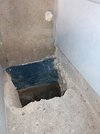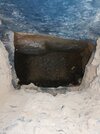I'm about to feed water pipes and power/data cables out from the attached garage to a new outbuilding. I've cut this hole into the garage floor...


The services will go down this hole then through the wall just above the footing, straight into a trench going to the outbuilding. I dug down to the footing to get as deep as possible, to reduce the frost risk on the outside.
Obviously I had to cut through the damp proof membrane to get down there. I made a mess of it with the breaker, then cut off the mess with a stanley knife. It's definitely all damp below it, it's dark coloured and feels cold.
I'm going to refill with concrete after fitting the pipes/cables. But a lump of concrete would then bridge this membrane. It won't be possible to cut a new sheet around the pipes/ducts, there will be four of them.
My ideas are...
1. Add a generous dose of damp proof additive to the concrete, fill the whole thing in one hit, job done.
2. Fill to the polythene, let it set, then pour some sort of waterproof sealant layer to seal around the pipes and onto the polythene, let it set then add more concrete up to floor level.
Obviously 2 would take much more time and effort than 1.
What's the normal way of dealing with this situation? Water and waste pipes commonly go through the membrane in new builds, how is this usually dealt with?


The services will go down this hole then through the wall just above the footing, straight into a trench going to the outbuilding. I dug down to the footing to get as deep as possible, to reduce the frost risk on the outside.
Obviously I had to cut through the damp proof membrane to get down there. I made a mess of it with the breaker, then cut off the mess with a stanley knife. It's definitely all damp below it, it's dark coloured and feels cold.
I'm going to refill with concrete after fitting the pipes/cables. But a lump of concrete would then bridge this membrane. It won't be possible to cut a new sheet around the pipes/ducts, there will be four of them.
My ideas are...
1. Add a generous dose of damp proof additive to the concrete, fill the whole thing in one hit, job done.
2. Fill to the polythene, let it set, then pour some sort of waterproof sealant layer to seal around the pipes and onto the polythene, let it set then add more concrete up to floor level.
Obviously 2 would take much more time and effort than 1.
What's the normal way of dealing with this situation? Water and waste pipes commonly go through the membrane in new builds, how is this usually dealt with?

